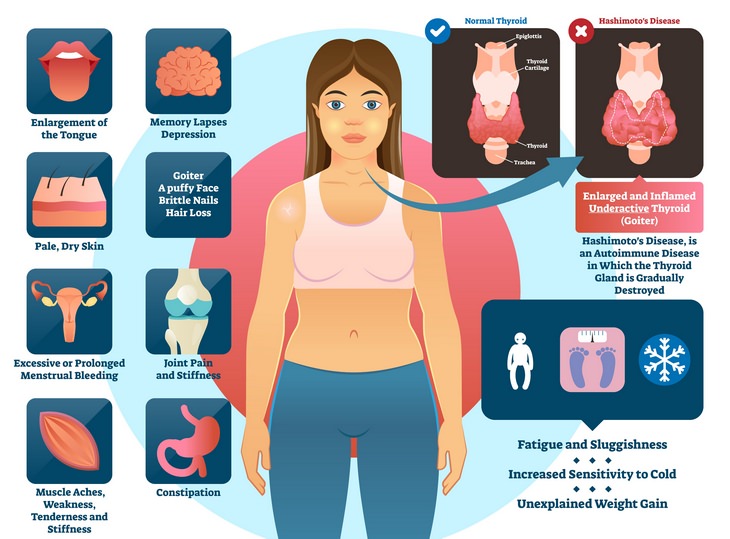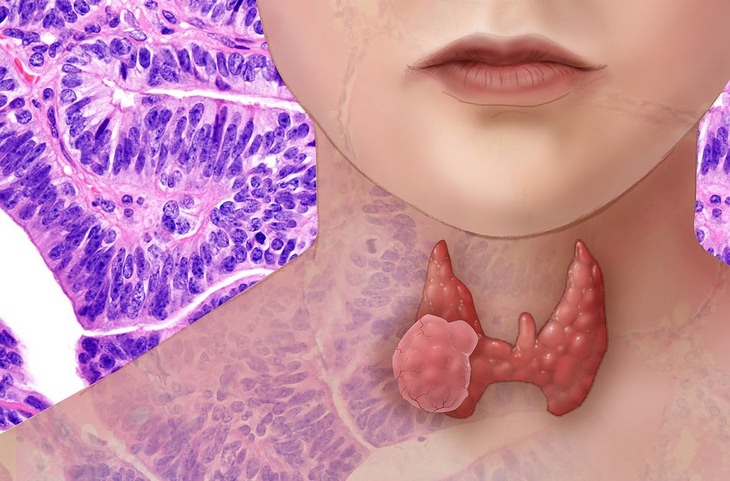1. Hypothyroidism
Hypothyroidism is a disorder that manifests in reduced activity in the thyroid gland. Because one of the main functions of the thyroid is regulating metabolism, an underactive gland causes slower metabolism. This, in turn, may cause inexplicable weight-gain, loss of appetite, constipation, dry and flaky skin, hair thinning, sensitivity to cold and depression.
In developing countries, the leading cause for hypothyroidism is a lack of dietary iodine, while in developed countries, hypothyroidism is typically associated with an autoimmune disease.
2. Hyperthyroidism
As you can probably tell by the name, this condition is the opposite of hypothyroidism and describes an overactive thyroid gland. Unsurprisingly, the symptoms of hyperthyroidism are nearly an exact mirror image of hypothyroidism: weight loss that is not tied to diet or activity and paired with an increased appetite, frequent diarrhea, irritability, confusion, an increased heartbeat, hand tremors, heat intolerance, sleep disorders, and mood swings.
Like hypothyroidism, the chief culprit behind hyperthyroidism are autoimmune diseases, and so it affects females to a much greater extent than men, but it also appears to be hereditary and can be caused by too much iodine in the diet.
3. Goiter
Rather than a thyroid disorder in and of itself, goiter is a symptom of other thyroid diseases. Goiter is a swelling of the neck due to an enlarged thyroid gland which can be caused by any thyroid disorder, but not having goiter doesn’t rule out a thyroid disorder.
It can present itself as a slight swelling of the neck, as a grapefruit-size globular swelling, or as several smaller balls in the neck. Goiter is typically painless, but a large goiter can make eating and breathing difficult.
4. Thyroid storm
Thyroid storm is a rare and life-threatening complication of an overactive thyroid (hyperthyroidism), which causes high fever, vomiting, and hypertension in early stages, followed by dramatically low blood pressure and circulatory shock in later stages. Thyroid storm could result in heart failure or heart attack.
Thyroid storm could be triggered by any number of conditions that aren’t related to the thyroid, such as blood poisoning, fever, dehydration and more. People are at larger risk of a thyroid storm if they leave their hyperthyroidism untreated or if they discontinue their hyperthyroidism treatment.
5. Hashimoto’s disease
Perhaps the leading cause of hypothyroidism in the west is Hashimoto’s disease, an autoimmune disease that causes the immune system to actively attack the thyroid gland. Though this may cause swelling in the thyroid (and goiter as a result), the overall effect is a gradual shrinking of the thyroid until its destruction.
As an autoimmune disease, Hashimoto’s disease is more common among people who suffer from other autoimmune diseases, specifically type 1 diabetes, celiac disease, vitiligo, and alopecia, but it is also genetic and could be inherited.
6. Graves’ Disease
Another autoimmune disease, Graves’ is the most common cause behind hyperthyroidism and can be initially triggered by stress, infection or childbirth. Additional symptoms of Graves’ are discolored, swollen shins with lesions or nodules, as well as eyes that bulge out.
Much like Hashimoto’s, people suffering from a preexisting autoimmune disease are more likely to develop Graves’ disease, and conversely, those with Graves’ are more likely to develop unrelated autoimmune conditions. There also appears to be a genetic factor.
7. Thyroid nodules
The most common thyroid problem and the cause of the least concern are nodules in the thyroid gland. These can be asymptomatic and imperceptibly small or present as lumps in the throat. In the case of goiter, one or more lumps are indicative of nodules. Only 5% of thyroid nodules are malign.
Problems swallowing or speaking and a hard, immobile lump are more indicative of malignancy, while a family history of autoimmune diseases and thyroid conditions accompanied by a nodule that is soft and painful are all signs of the nodule being benign.
Thyroid nodules are extremely common, with about 50% of people having a nodule at some point in their life. Other thyroid conditions, such as Hashimoto’s and Graves’ will often cause nodules as well.
8. Thyroid cancer
Most types of thyroid cancer have an excellent prognosis and are very manageable, as they do not tend to metastasize. Though not overly common, diagnosed cases are on the rise, but that may very well be due to better detection, rather than the cancer being on the rise.
The lack of detection in the past may be due to a lack of complaints from patients, who did not realize something was wrong to begin with. There are four types of thyroid cancer:
- Papillary
- Follicular
- Medullary
- Anaplastic.
Of those, only anaplastic thyroid cancer, which is an extremely rare, fast-acting and metastasizing type of cancer, is of great concern. For the other three types of cancer, the survival rate over five years is 90% and 84% over ten years.
 Go to BabaMail
Go to BabaMail




 Source:
Source: 



 Source:
Source: 





















